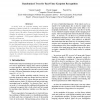Free Online Productivity Tools
i2Speak
i2Symbol
i2OCR
iTex2Img
iWeb2Print
iWeb2Shot
i2Type
iPdf2Split
iPdf2Merge
i2Bopomofo
i2Arabic
i2Style
i2Image
i2PDF
iLatex2Rtf
Sci2ools
112
click to vote
CVPR
2005
IEEE
2005
IEEE
Randomized Trees for Real-Time Keypoint Recognition
In earlier work, we proposed treating wide baseline matching of feature points as a classification problem, in which each class corresponds to the set of all possible views of such a point. We used a K-mean plus Nearest Neighbor classifier to validate our approach, mostly because it was simple to implement. It has proved effective but still too slow for real-time use. In this paper, we advocate instead the use of randomized trees as the classification technique. It is both fast enough for real-time performance and more robust. It also gives us a principled way not only to match keypoints but to select during a training phase those that are the most recognizable ones. This results in a real-time system able to detect and position in 3D planar, non-planar, and even deformable objects. It is robust to illuminations changes, scale changes and occlusions.
Computer Vision | CVPR 2005 | Illuminations Changes | Nearest Neighbor Classifier | Real-time Performance | Real-time Use | Wide Baseline Matching |
| Added | 12 Oct 2009 |
| Updated | 12 Oct 2009 |
| Type | Conference |
| Year | 2005 |
| Where | CVPR |
| Authors | Vincent Lepetit, Pascal Lagger, Pascal Fua |
Comments (0)

